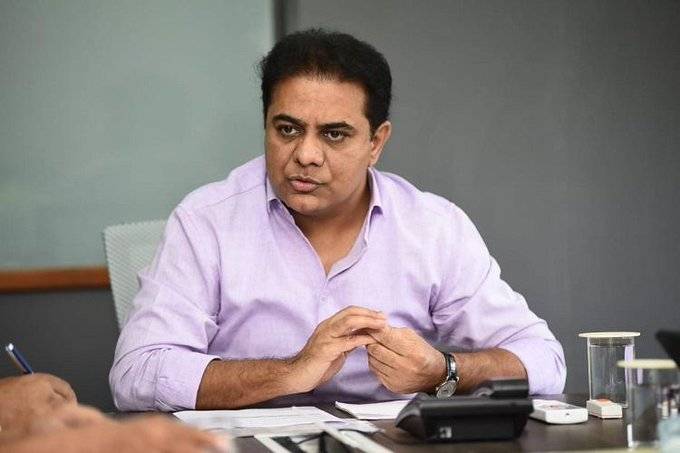Citing Reserve Bank of India (RBI) report of October 2021, KTR said Telangana with 2.5 per cent of Indian population contributes 5.0 per cent to India’s GDP…reports Asian Lite News
Telangana’s minister for industry and information technology K.T. Rama Rao on Sunday said during the last eight years India’s debt rose by Rs 100 lakh crore.
He claimed that every Indian has a debt of Rs 1.25 lakh. His tweet on Sunday was apparently in response to Union Finance Minister Nirmala Sitharaman’s statement that every child born in Telangana carries a debt of Rs.1.25 lakh.
The Central minister, during her three-day visit to Zaheerabad Lok Sabha constituency under BJP’s ‘Parliament Pravas Yojana’, had slammed the state government for raising debts.
Rama Rao, who is also working president of Telangana Rashtra Samithi (TRS), tweeted ‘Madam FM waxes eloquent on Fiscal prudence; Till 2014, in 67 years 14 Prime Ministers of India together have raised a debt of Rs. 56 Lakh Crores Then came PM Modi Ji; in the last 8 years alone India’s debt incremented by Rs.100 Lakh Crores Every Indian has a debt of Rs.1.25 Lakh”
KTR, as Rama Rao is popularly known, pointed out that per capita income of Telangana in 2022 is Rs 2.78 lakh while the national average per capita income is Rs 1.49 lakh.
The minister said while the debt to GSDP ratio of Telangana is 23.5 per cent, lowest at 23rd among the 28 Indian states, the nation’s debt to GDP ratio is 59 per cent.
Citing Reserve Bank of India (RBI) report of October 2021, KTR said Telangana with 2.5 per cent of Indian population contributes 5.0 per cent to India’s GDP.
He remarked that the country needs double impact governance and not futile double engines. He said if only BJP states had performed on par with Telangana, India would now be a $4.6 Trillion economy.
Sitharaman had come down heavily on the TRS government for raising debts beyond FRBM limits and claimed that every child born in the state carries Rs 1.25 lakh debt burden.
She said because of the huge debts, Telangana’s revenue surplus budget had slipped to a revenue deficit budget.
She said the state was raising more debts than approved in the Budget. She claimed that the Assembly was being kept in the dark about the debts raised outside. She said all the debts were not being included in the Budget.
The central minister had argued that the Centre has the right to question the state on debts.
Meanwhile, India’s external debt of $620.7 billion, as at end of March 2022, is sustainable and is being managed in a prudent manner, the Department of Economic Affairs, under the Union Finance Ministry, said.
In a recent report, the Department of Economic Affairs said the country’s external debt continues to be sustainable and prudently managed.
“As at end-March 2022, it stood at $620.7 billion, growing by 8.2 per cent over the level a year ago. External debt as a ratio to GDP (gross domestic product) was 19.9 per cent, while reserves to external debt ratio was 97.8 per cent,” the report said.
The sovereign debt at $130.7 billion rose higher by 17.1 per cent over its level a year ago, mainly because of additional allocation of special drawing rights (SDR) by the IMF during 2021-22.
The non-sovereign debt, on the other hand, grew 6.1 per cent to $490 billion over the level as at end-March 2021.
Experts had said that the external debt of $620.7 billion need not be a concern as $490 billion is non-government and the share of government is only $130.8 billion.
Of the non-government debt, the share of non-financial corporations was about $250.2 billion.
Further, the total debt of $620.7 billion as a percentage of gross domestic product (GDP) was 19.9 per cent and the debt service ratio was 5.2 per cent.
Experts also said India cannot be compared with Sri Lanka that is in a severe economic crisis.
The share of the central government in short term debt – maturing in a year’s time- is only $7.7 billion out of the total $267 billion, experts had said.
Commercial borrowings, NRI deposits, and short-term trade credit are the three biggest constituents of the non-sovereign debt, accounting for as much as 95.2 per cent.
While NRI deposits declined by two per cent to $139 billion, commercial borrowings at $209.71 billion and short-term trade credit at $117.4 billion rose by 5.7 per cent and 20.5 per cent, respectively.
According to the report, the debt vulnerability indicators continued to be benign. The debt service ratio fell significantly to 5.2 per cent during 2021-22 from 8.2 per cent during the previous year, reflecting buoyant current receipts and moderating external debt service payments.
The debt service payment obligations arising out of the stock of external debt as at end of March 2022 are projected to trend downwards over the coming years.
From a cross-country perspective, India’s external debt is modest. In terms of various debt vulnerability indicators, India’s sustainability was better than the Low-and Middle-Income Countries (LMICs) as a group and vis-a-vis many of them individually.
According to the report, the US dollar continues to be the leading currency of denomination accounting for 53.2 per cent of the total as at end March 2022.
Deposits in Non Resident (External) Rupee Accounts (NR(E)RA), NRO accounts and FPI investments in Gsec and corporate bonds are among the components of India’s external debt, denominated in Indian rupees.
Indian rupee is the second leading currency of denomination with a lower share of 31.2 per cent of the total as at end-March 2022 than 33.3 per cent a year ago, reflecting erosion of outstanding FPI investments in G-Sec and corporate bonds ($50.1 billion from $51.4 billion as at end-March 2021) and balances under NRE accounts ($100.8 billion from $ 102.6 billion). Following the US dollar and the Indian rupee are the SDRs (6.6 per cent), the Japanese Yen (5.4 per cent) and Euro (2.9 per cent).

